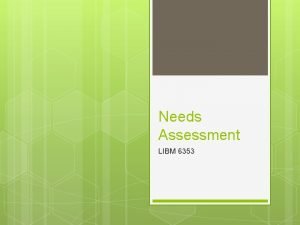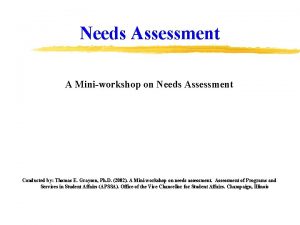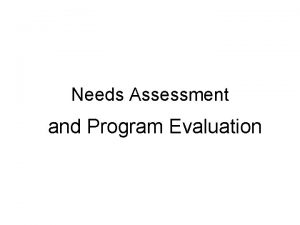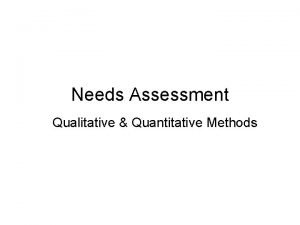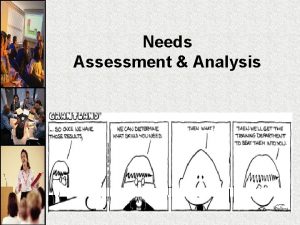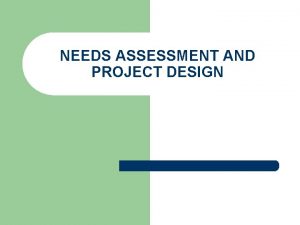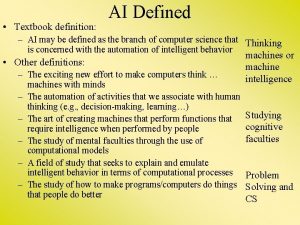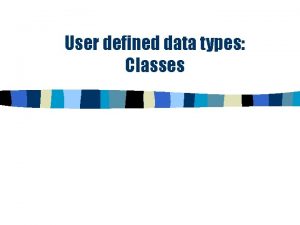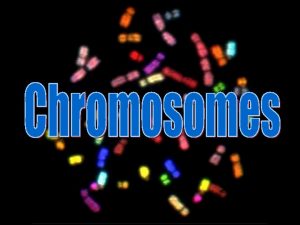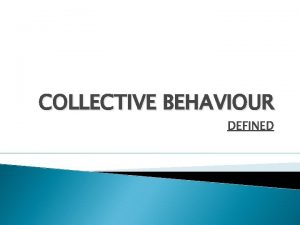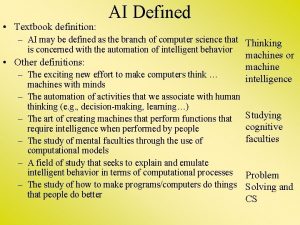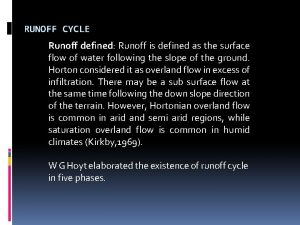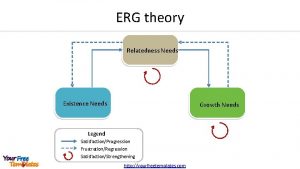Chapter 3 Needs Assessment Needs Assessment defined The



























- Slides: 27

Chapter 3: Needs Assessment

Needs Assessment, defined: The measure against which program implementation and outcome will be compared. “A needs assessment should be conducted to ensure that scarce resources are being utilized in the best way, as well as to determine further funding. ” (Royse, et al. )

Needs Assessment Can provide valuable info for program planning, such as: ü What groups to target for service ü The best way to publicize the services ü Estimate who can benefit from services ü Geographic location of potential clients ü Barriers that may be encountered

Why do we need to conduct a Needs Assessment? To document the existence of an ongoing social problem To prioritize the need for social services To determine whether interventions and other resources to address the identified needs exist in a community. To determine whether existing interventions are known to or are acceptable to potential clients To determine the major barriers that might prevent clients from accessing existing services To determine whethere are enough clients with a certain problem to justify creating a new program To obtain info. for tailoring a program to a specific target population

Four types of Need : (Bradshaw, 1977) ü Normative Need: A condition or situation defined by an expert. These needs are strongly affected by the knowledge of the expert. However, normative needs can be biased. ü Felt Need: Perceptions of need are ascertained by consulting actual clients. Felt need is collected by surveying clients. However, surveys may yield unrepresentative samples, or low response rates. (ex. Mail-out surveys, or telephone surveys)

Four types of Need, cont. ü Expressed Need: A demand for service. For example, the clients who have applied for services. A problem with this approach is that although many individuals could benefit from services, they may not be receiving them. ü Comparative Need: An inferred measure of need determined by examining the characteristics of those receiving services and then locating those characteristics in the population. However, this approach is vulnerable to problems of unrepresentative-ness.

Before beginning a needs assessment… Ask yourself: What useful information sources are available?

Steps in a Needs Assessment: 1) Clearly Understand: - The purpose of the needs assessment - The level of the assessment - What stakeholders to include, such as clients or potential clients, community leaders, state officials, etc. - Budget & available resources - Time allowed for the project.

Steps in a Needs Assessment, cont. 2) Identify the specific information you need to acquire. 3) Determine whether the info already exists or can be obtained with your resources. 4) Design the methodology and instrumentation 5) Collect and analyze the data.

Steps in a Needs Assessment, cont. 6) Prepare the Report 7) Disseminate preliminary results to key stakeholders to obtain feedback 8) Formally disseminate your results.

Needs Assessment Approaches: There a variety of ways to estimate the need for a human service program. Many questions should be asked: How much can be spent on the needs assessment? Can you afford consultants and paid interviewers? What kind of technical expertise will be available? How much detail is desired? What programs are most similar to the one you must assess? And how was need for those programs determined?

Secondary Data Analysis Refers to existing info that comes from consensus data, public documents and reports. Consensus data is readily available and should be reviewed before collecting any other data. www. census. gov Additionally, statistics and information from over 70 federal government agencies can also be found at www. fedstats. gov.

Secondary Data Analysis Administrative records, reports and files from within your own agency should also be examined for need assessment purposes. This readily existing information from the agency itself is called: patterns of use, or client utilization data.

Secondary Data Analysis Secondary data sources are usually convenient and easy to access and understand. However, the data can be outdated, unreliable, incomplete or from an agency that is not similar to yours, or misinterpretation of the data can occur.

Impressionistic Approaches After consulting the secondary data, key informants should be consulted. Key informants are those people who are informed about the given problem because of training or work experience. Impressionistic approaches have a subjective quality to themthey are not as accurate as large scale community surveys, and they are largely based on the opinions of these key informants. On a positive note, they involve the community, are inexpensive and relatively quick to implement.

Impressionistic Approaches § Public Hearings & Community Forums= more grassroot oriented. § Nominal Group Technique= involves a small group of people who, in response to a common problem, work independently at first, and then share their ideas. The group conducts a group discussion in which they can elaborate, eliminate combine or add new ideas to the list. § The Delphi Technique= involves the use of a questionnaire that is distributed to a panel of key experts. Their ideas are solicited and replies are compiled. § Focus Groups= represent another perception-oriented approach to assessing needs. They usually involve 6 -8 people who participate in a structured discussion. The goal is to identify and delineate their particular needs.

Surveys are exceptionally valuable tools to use for needs assessments!

Surveys They provide information that is much more objective and scientific than impressionistic approaches, however, they require more planning and resources. Random sampling can be employed to make sure that there is an equal chance of being selected and to be representative of the opinions of your population.

Convergent Analysis & Multimethod Approaches Convergent Analysis involves using multiple sources of info. and different assessment strategies and perspectives. This typically gives the needs assessment more credibility. Because all needs assessment approaches have conceptual, empirical and inferential problems, a multimethod approach to needs assessment is often recommended in order to reduce the underlying problems found with a single method.

Community Readiness Once the needs assessment is complete, it is important to consider: Will the community be receptive to the new program? Community resistance can make the implementation of the program very difficult. What works in one community may not necessarily work in another.

Community Readiness Model: Identifies 9 stages of readiness Stage 1: No Awareness- In this stage, community leadership tolerates the problem behavior in certain contexts. There are no formal or informal policies in place regarding the behavior. Stage 2: Denial- In this stage, the community recognizes that the behavior is or can be a problem, but not as a local problem. Community leaders are passive and apathetic.

Community Readiness Model: Stage 3: Vague Awareness- Community leaders generally recognize the behavior as a local problem and that something should be done about it, but there is no immediate motive to do anything. Policies may exist, but may be inconsistently followed. Stage 4: Preplanning- At least some community leaders recognize the local problem, however efforts are not focused or detailed. Discussion of the problem occurs, but no real planning or actions address the problem.

Community Readiness Model: Stage 5: Preparation. Leadership is active and energetic. Planning is occurring, and decisions are being made about what will be done. Resources are being actively sought, however community climate may or may not support efforts. Stage 6: Initiation- An activity or action has been started and is underway, but is still viewed as a new effort. Staff are in training and leaders may feel enthusiastic about these efforts. However, limitations and problems have not yet been experienced.

Community Readiness Model: Stage 7: Stabilization. One or two programs are running and are supported. Staff are trained and experienced. Policies are known to most community members. There may be some criticism, but generally the community climate is supportive. Stage 8: Confirmation & Expansion- Standard programs, policies, and activities are in place. Authorities and community leaders support is expanding. Data regularly obtained and efforts are made to assess risk factors. New efforts are being planned in order to reach more people.

Community Readiness Model: Step 9: Professionalization- Detailed and sophisticated knowledge of prevalence, risk factors and causes of the problem exist. Highly trained staff are running the programs; community involvement is high. Effective evaluation is used to evaluate the program, policies and activities.

Once the level of readiness is assessed, further planning for the program can be undertaken

The End! Reference:
 What is a collection of well defined objects
What is a collection of well defined objects Primary needs and secondary needs
Primary needs and secondary needs Satisfaction
Satisfaction Henry murray theory
Henry murray theory Strategic gender needs and practical gender needs
Strategic gender needs and practical gender needs Present situation analysis in esp
Present situation analysis in esp Hát kết hợp bộ gõ cơ thể
Hát kết hợp bộ gõ cơ thể Ng-html
Ng-html Bổ thể
Bổ thể Tỉ lệ cơ thể trẻ em
Tỉ lệ cơ thể trẻ em Gấu đi như thế nào
Gấu đi như thế nào Chụp phim tư thế worms-breton
Chụp phim tư thế worms-breton Chúa yêu trần thế
Chúa yêu trần thế Môn thể thao bắt đầu bằng từ chạy
Môn thể thao bắt đầu bằng từ chạy Thế nào là hệ số cao nhất
Thế nào là hệ số cao nhất Các châu lục và đại dương trên thế giới
Các châu lục và đại dương trên thế giới Công thức tính độ biến thiên đông lượng
Công thức tính độ biến thiên đông lượng Trời xanh đây là của chúng ta thể thơ
Trời xanh đây là của chúng ta thể thơ Mật thư anh em như thể tay chân
Mật thư anh em như thể tay chân 101012 bằng
101012 bằng độ dài liên kết
độ dài liên kết Các châu lục và đại dương trên thế giới
Các châu lục và đại dương trên thế giới Thơ thất ngôn tứ tuyệt đường luật
Thơ thất ngôn tứ tuyệt đường luật Quá trình desamine hóa có thể tạo ra
Quá trình desamine hóa có thể tạo ra Một số thể thơ truyền thống
Một số thể thơ truyền thống Cái miệng bé xinh thế chỉ nói điều hay thôi
Cái miệng bé xinh thế chỉ nói điều hay thôi Vẽ hình chiếu vuông góc của vật thể sau
Vẽ hình chiếu vuông góc của vật thể sau Thế nào là sự mỏi cơ
Thế nào là sự mỏi cơ





























